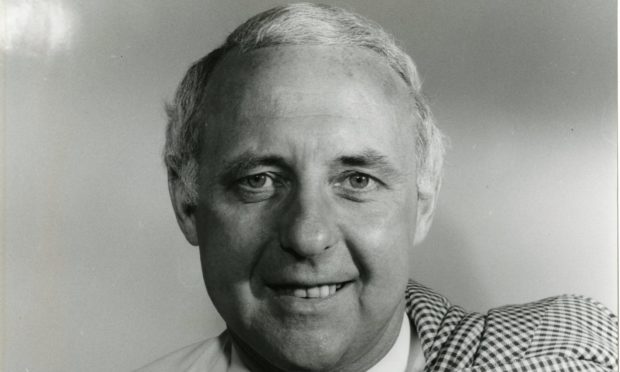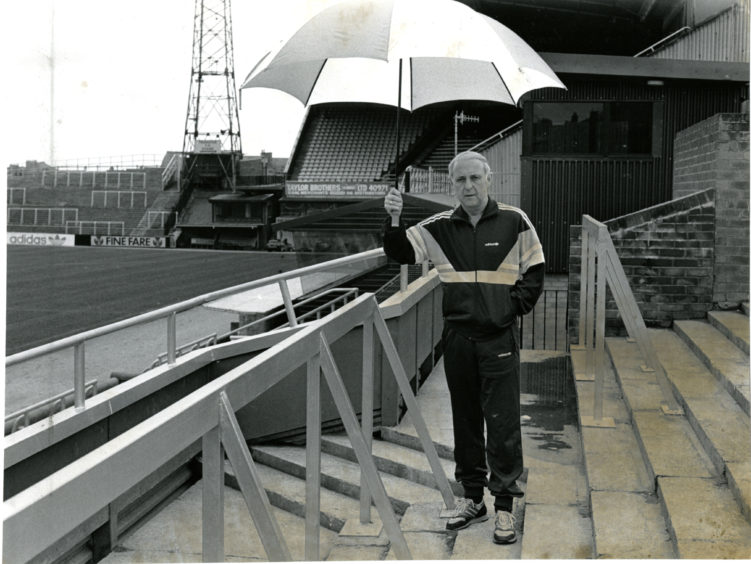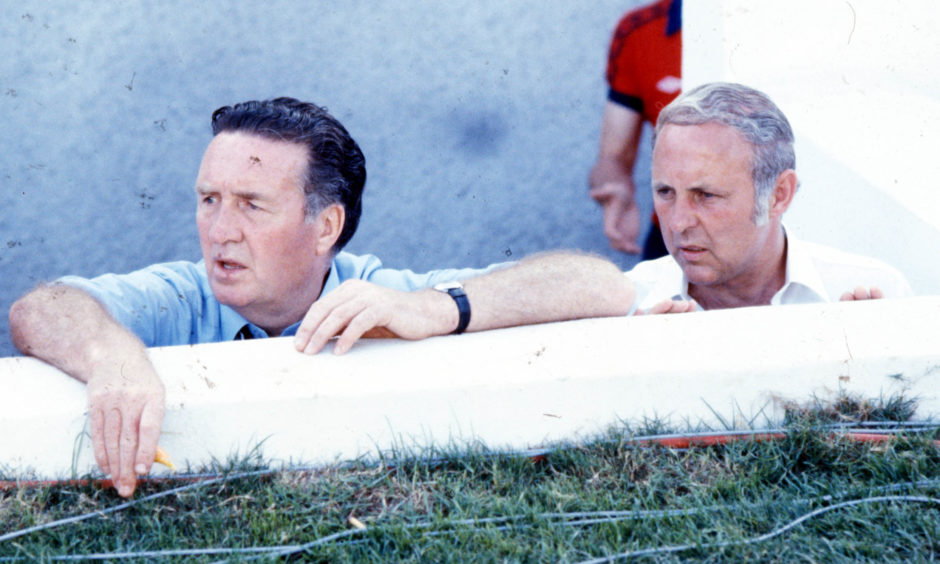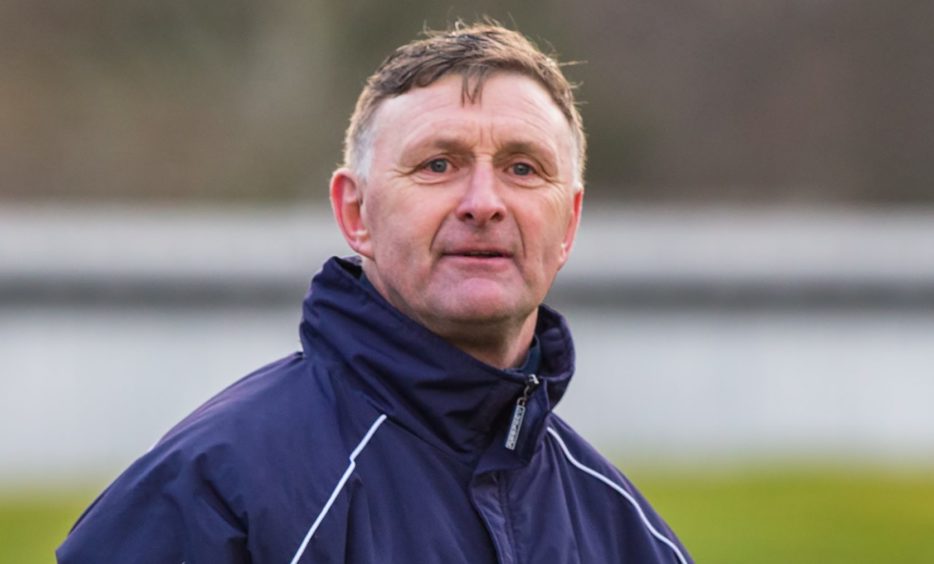Jim Mclean’s passing leaves me asking a question which requires only one second to answer.
When will we see his like again?
The man who transformed a medium-sized Scottish club into a playing unit feared throughout Europe, taming the giants of Barcelona and Borussia Monchengladbach among others, was a one off.
He could be complex and cussed, he could captivate and charm and he could frighten and fluster.
His single-minded 24-hour-a-day approach to football transformed Dundee United from a club nicknamed the Terrors before he arrived – for their never say die attitude – into a super-fit and stylish side which in its pomp could play the game with supreme quality.
He was never off duty.
On Sunday afternoons in my early twenties I would play a bounce game with a group of lads at the Kirkton High playing fields.
A few of the boys were professionals with Jim Morton of St Johnstone, and Billy Gavine of Arbroath, plus a scattering of junior players along with the hackers like me.
The star of the show was Graeme Payne, who had been playing against Celtic or Rangers or some other outfit in top-flight football the previous day and was now kicking a ball about with his mates.
Every now and again he would duck down out of sight behind some of the boys, because he thought he’d spotted Jim’s car, the manager out checking to see what his players were up to.
‘He never switched off from the game’
Playing in a bounce game with his pals and risking injury was certainly on Jim’s banned list and would’ve incurred one of his infamous fines.
Jim was regularly to be seen watching Sunday boys’ games at public parks in the city, scouring the pitches for future stars.
He never switched off from the game.
The recent play about his life at Dundee Rep, Smile, captured the idiosyncrasies of a man who along with Jock Stein and Sir Alex Ferguson is one of the three all-time giants of Scottish football management.
As a manager he coached, cajoled, and coaxed United to magnificent achievements and feats which shouldn’t have been possible given the limitations of the club’s size and crowds.
He transformed them and produced a string of household names, who both in Scotland and beyond achieved great things in the game.
The list is longer than the Tannadice pitch: David Narey, Paul Hegarty, Eamonn Bannon, Paul Sturrock, Andy Gray, Raymond Stewart, Duncan Ferguson, Christian Dailly and Kevin Gallacher are just some of the talents he produced to thrill a generation of supporters.
A veritable galaxy of stars were developed either through his legendary Tannadice youth system, or signed thanks to his keen eye for a top prospect.
He paid big money to strengthen United when he needed to, splashing out £165,000 for Bannon from Chelsea in 1979, a Scottish transfer record at the time, having also forked out £100,000 for Willie Pettigrew from Motherwell, a player whom Celtic and Bayern Munich had been keen on.
In those days those were seriously big fees and showed the extent of his ambition for United to compete with the best.
McLean’s innovation
In terms of training he was well ahead of his time using sprint coaches and dieticians, and his tactical nous was second to none.
On occasions when signings looked as though they might not work, he wasn’t afraid to experiment.
He signed Paul Hegarty from Hamilton Accies as a striker and ended up transforming him into a centre half who became one of the finest in the UK in that position.
In later years Paul would discover that Spurs had apparently made a big offer for him which would have quintupled his wages but Jim managed to keep that from him and retained his services at Tannadice.
His single-mindedness in similar situations were often to the club’s advantage but not the players.
He also on occasion pulled some very strange signings out of the hat with variable results.
Peter Bonetti the former Chelsea and England keeper who had retired and was working in the Isle of Mull was signed after Jim had fallen out with the legendary Hamish McAlpine, and he played seven games with mixed fortunes before swiftly resuming island life.
At the time United had a policy of players living within a short radius of the city and it’s fair to say that the rules were bent somewhat for Bonetti who was resident in the hamlet of Fionnphort over 150 miles away.
As a journalist, a cautious wariness when dealing with him was always advisable.
On one occasion while working for BBC Scotland I broke a story about two Irish investors who had written to Jim, enquiring about buying shares in United.
As the presenter Richard Gordon was asking me on live radio how Jim had reacted to the offer, the Tannadice supremo could clearly be heard bawling at me as he stormed towards the radio gantry to remonstrate.
In fairness to him once I produced a copy of the offer letter which I had previously (ahem) acquired, he calmed down, and the next week it was as though the incident had never happened.
He lived, breathed, and slept the game.
On one occasion a pal of mine who was a police officer had written to Jim expressing his strong views on a sub-par United performance.
The next week there was a knock at his door and there was the United boss on the doorstep to discuss the criticisms.
An hour later after a cup of tea in the living room and a good chinwag, my mate was left with an entirely different view of a manager who would go to such lengths to explain his methods to a fan.
At a kickboxing dinner one night he and I were seated together when he leaned across to tell me something.
I assumed I was about to be told off for a story which he hadn’t liked.
Instead he brusquely informed me that while he didn’t always agree with my radio comments, he had always respected me as a journalist.
From Jim that was high praise indeed, and I admit I spent the rest of the night waiting on his punchline that he had in fact been winding me up.
Some former players have strong views on his management style which could be unforgiving and there’s no point in hiding from that, but they also acknowledge his superb abilities as a coach and tactician.
‘We’ll never again see a manager achieve this kind of success’
As a manager and a chairman he enjoyed huge power at United.
He could have gone elsewhere, refusing an offer to manage Rangers, to concentrate instead on building United into a serious force in the land, respected throughout the European game.
With the advent of the Bosman ruling and freedom of movement for players, and the arrival of huge television money, it’s unlikely that in the modern day we’ll ever again see a manager who can achieve anything approaching the success which Jim McLean brought to Tannadice.
Statement from the McLean family: pic.twitter.com/ty5gWs7MUF
— Dundee United FC (@dundeeunitedfc) December 26, 2020
He was truly a unique individual who with his drive, determination, and work ethic lifted a club which was the second biggest in the city when he arrived, to heights undreamt of both domestically and in Europe.
He was truly a one off. We’ll not see his like again.





